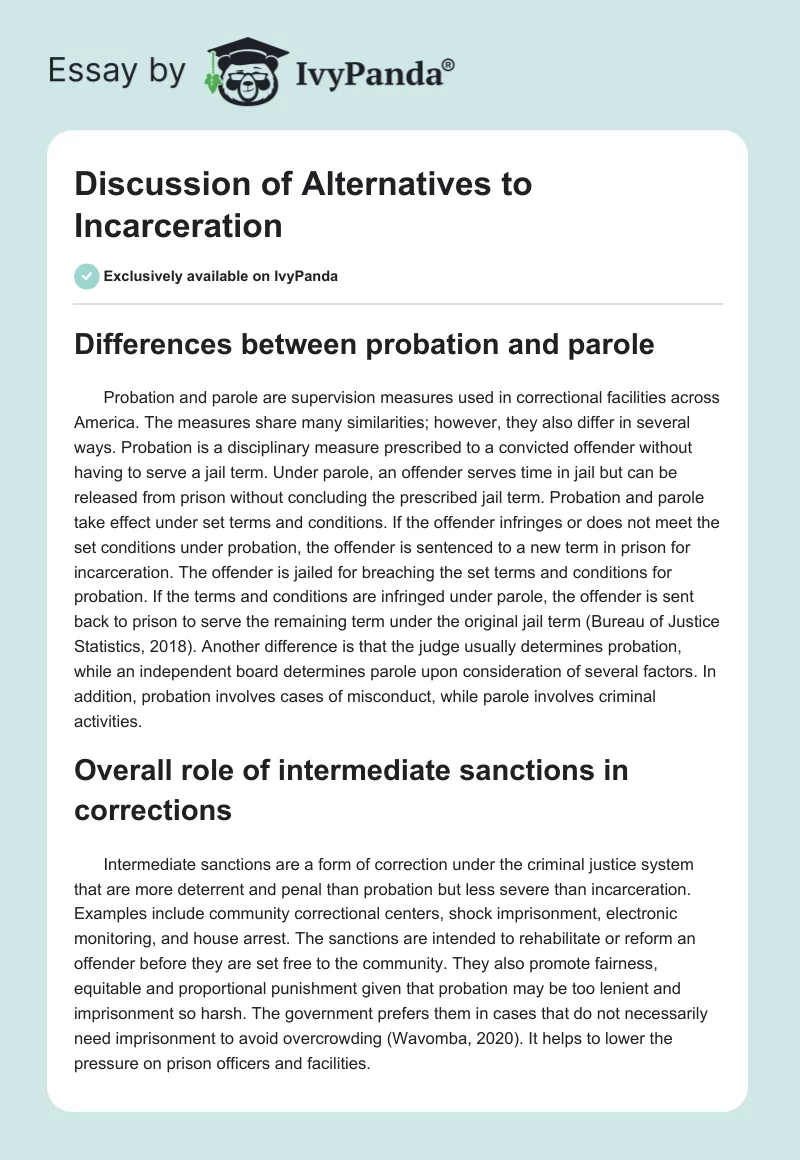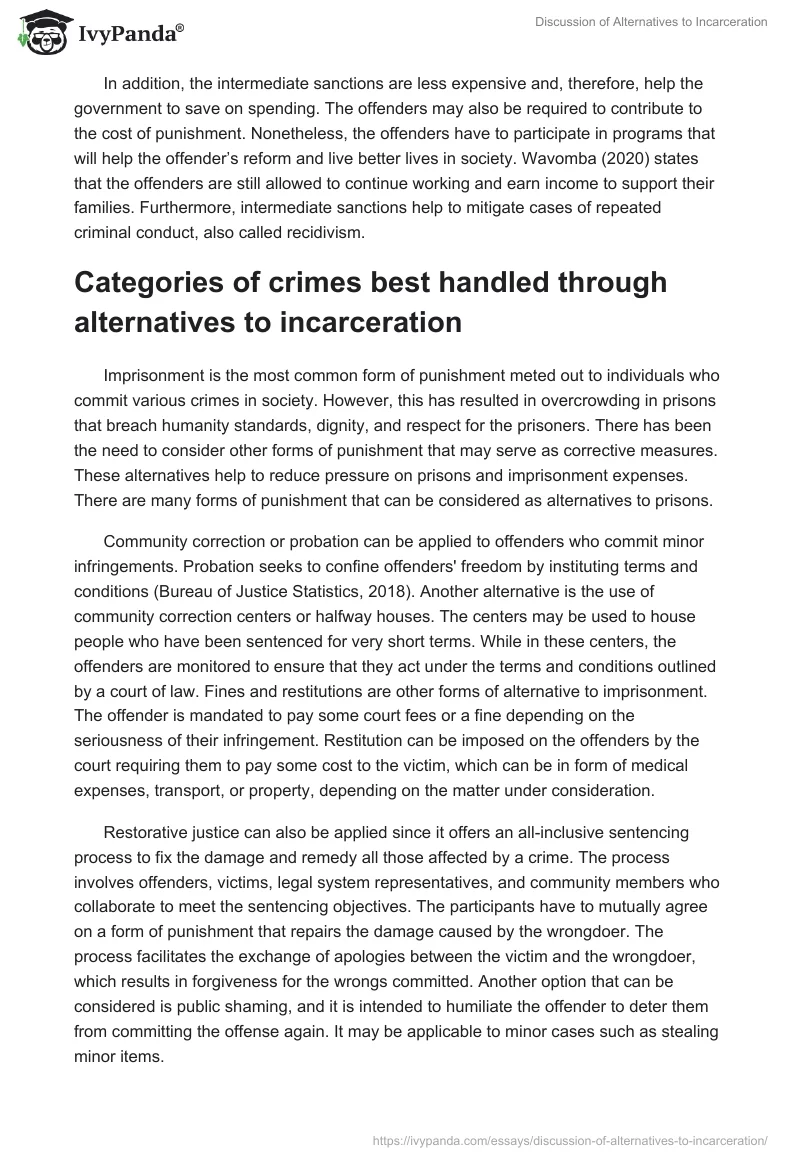Differences between probation and parole
Probation and parole are supervision measures used in correctional facilities across America. The measures share many similarities; however, they also differ in several ways. Probation is a disciplinary measure prescribed to a convicted offender without having to serve a jail term. Under parole, an offender serves time in jail but can be released from prison without concluding the prescribed jail term. Probation and parole take effect under set terms and conditions. If the offender infringes or does not meet the set conditions under probation, the offender is sentenced to a new term in prison for incarceration. The offender is jailed for breaching the set terms and conditions for probation. If the terms and conditions are infringed under parole, the offender is sent back to prison to serve the remaining term under the original jail term (Bureau of Justice Statistics, 2018). Another difference is that the judge usually determines probation, while an independent board determines parole upon consideration of several factors. In addition, probation involves cases of misconduct, while parole involves criminal activities.
Overall role of intermediate sanctions in corrections
Intermediate sanctions are a form of correction under the criminal justice system that are more deterrent and penal than probation but less severe than incarceration. Examples include community correctional centers, shock imprisonment, electronic monitoring, and house arrest. The sanctions are intended to rehabilitate or reform an offender before they are set free to the community. They also promote fairness, equitable and proportional punishment given that probation may be too lenient and imprisonment so harsh. The government prefers them in cases that do not necessarily need imprisonment to avoid overcrowding (Wavomba, 2020). It helps to lower the pressure on prison officers and facilities.
In addition, the intermediate sanctions are less expensive and, therefore, help the government to save on spending. The offenders may also be required to contribute to the cost of punishment. Nonetheless, the offenders have to participate in programs that will help the offender’s reform and live better lives in society. Wavomba (2020) states that the offenders are still allowed to continue working and earn income to support their families. Furthermore, intermediate sanctions help to mitigate cases of repeated criminal conduct, also called recidivism.
Categories of crimes best handled through alternatives to incarceration
Imprisonment is the most common form of punishment meted out to individuals who commit various crimes in society. However, this has resulted in overcrowding in prisons that breach humanity standards, dignity, and respect for the prisoners. There has been the need to consider other forms of punishment that may serve as corrective measures. These alternatives help to reduce pressure on prisons and imprisonment expenses. There are many forms of punishment that can be considered as alternatives to prisons.
Community correction or probation can be applied to offenders who commit minor infringements. Probation seeks to confine offenders’ freedom by instituting terms and conditions (Bureau of Justice Statistics, 2018). Another alternative is the use of community correction centers or halfway houses. The centers may be used to house people who have been sentenced for very short terms. While in these centers, the offenders are monitored to ensure that they act under the terms and conditions outlined by a court of law. Fines and restitutions are other forms of alternative to imprisonment. The offender is mandated to pay some court fees or a fine depending on the seriousness of their infringement. Restitution can be imposed on the offenders by the court requiring them to pay some cost to the victim, which can be in form of medical expenses, transport, or property, depending on the matter under consideration.
Restorative justice can also be applied since it offers an all-inclusive sentencing process to fix the damage and remedy all those affected by a crime. The process involves offenders, victims, legal system representatives, and community members who collaborate to meet the sentencing objectives. The participants have to mutually agree on a form of punishment that repairs the damage caused by the wrongdoer. The process facilitates the exchange of apologies between the victim and the wrongdoer, which results in forgiveness for the wrongs committed. Another option that can be considered is public shaming, and it is intended to humiliate the offender to deter them from committing the offense again. It may be applicable to minor cases such as stealing minor items.
Categories of crimes that can be changed to civil infractions (fines only) instead of criminal acts (possibility of incarceration)
Courts have the power to impose fines on criminal offenses. For minor offenses, the payable fines are fixed by the courts. As cases become more serious, separate fines are imposed depending on the category of crime committed. Some crimes whose sentence can be converted into civil infractions instead of incarceration include battery, assault, minor drug crimes, minor shoplifting, minor motor vehicle offenses, and criminal aggravation. Conversion of crimes requires an application to the court under the applicable sections of the law. The conversion is beneficial to perpetrators due to the seriousness that society attaches to criminal acts. For instance, a misdemeanor case may seriously affect the prospect of an individual securing a job. However, the perpetrator may be required to pay extra fines in the form of restitution.
References
Wavomba, Z. (2020). Advantages of Intermediate Sanctions in Sentencing. Legal Beagle. Web.
Bureau of Justice Statistics. (2018). Probation and Parole in the United States. Web.


